2004 DODGE GRAND CARAVAN child seat
[x] Cancel search: child seatPage 10 of 397

m Vehicle Theft Alarm Ð If Equipped ...........26
m Sliding Side Door ........................28
N Power Sliding Door Ð If Equipped .........29
N Child Protection Door Lock ...............32
m Liftgate ...............................33
N Power Liftgate Ð If Equipped .............34
m Windows .............................36
N Manual Rear Vent Windows ...............36
N Power Vent Windows Ð If Equipped ........36
N Power Windows Ð If Equipped ............37
m Occupant Restraints ......................38
N Lap/Shoulder Belts .....................39 N Lap/Shoulder Belt Untwisting Procedure .....45
N Center Lap Belts .......................47
N Seat Belt Pretensioners ...................47
N Seat Belts And Pregnant Women ............48
N Seat Belt Extender ......................48
N Driver And Front Passenger Supplemental
Restraint System - Airbag ................48
N Side Airbags Supplemental Restraint System
(SRS) Ð If Equipped ....................54
N DaimlerChrysler Corporation Integrated Child
Seat Ð If Equipped .....................58
N Child Restraint ........................5810 THINGS TO KNOW BEFORE STARTING YOUR VEHICLE
Page 11 of 397

m Rear Seat Delete Feature
(Commercial Vehicles Only) Ð If Equipped .....66
N Restraining Infants And Small Children With
Seat Delete Feature (Commercial Vehicles
Only) ...............................67
m Engine Break-In Recommendations ...........70 m Safety Tips ............................71
N Exhaust Gas ..........................71
N Safety Checks You Should Make Inside The
Vehicle ..............................71
N Periodic Safety Checks You Should Make
Outside The Vehicle ....................72THINGS TO KNOW BEFORE STARTING YOUR VEHICLE 11
2
Page 32 of 397
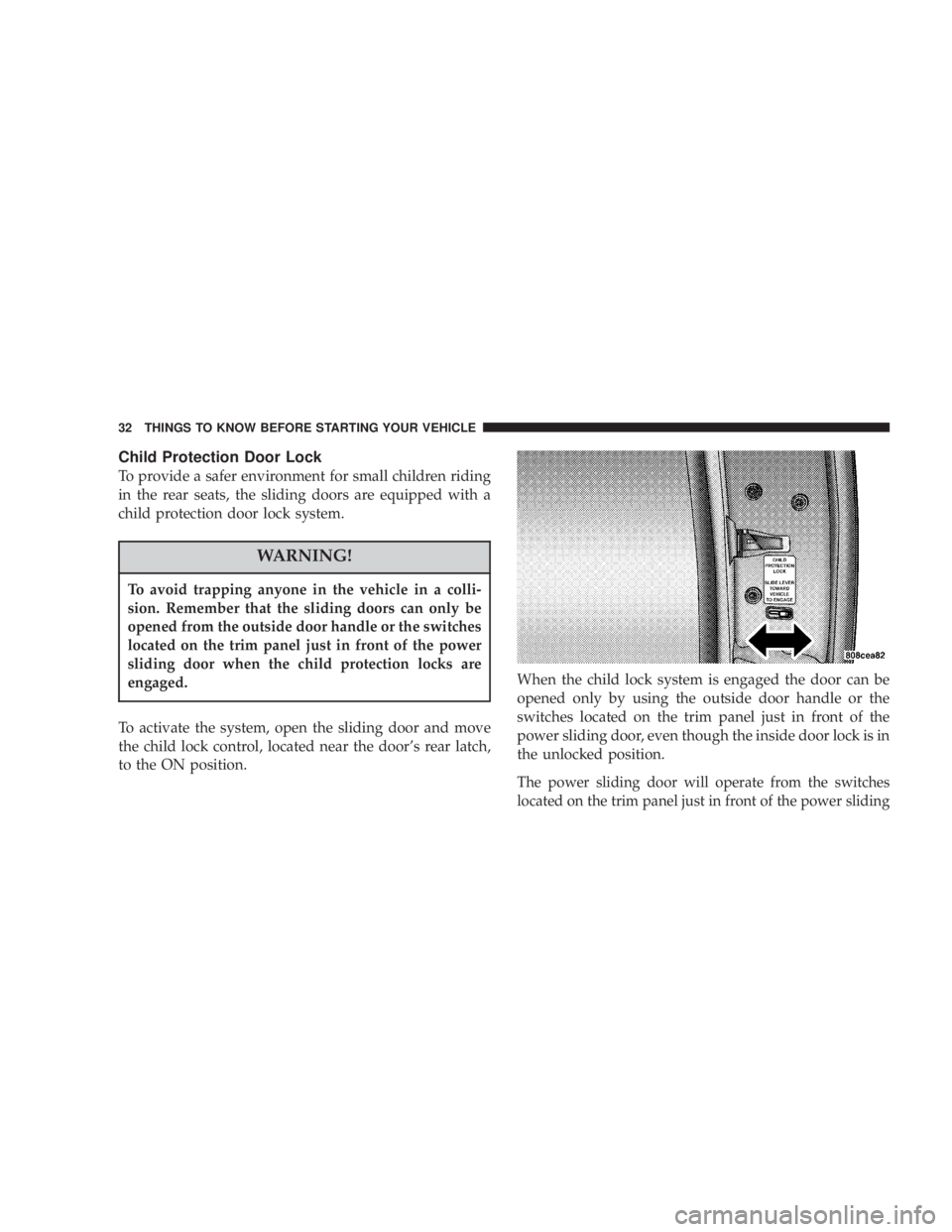
Child Protection Door Lock
To provide a safer environment for small children riding
in the rear seats, the sliding doors are equipped with a
child protection door lock system.
WARNING!To avoid trapping anyone in the vehicle in a colli-
sion. Remember that the sliding doors can only be
opened from the outside door handle or the switches
located on the trim panel just in front of the power
sliding door when the child protection locks are
engaged.
To activate the system, open the sliding door and move
the child lock control, located near the door's rear latch,
to the ON position. When the child lock system is engaged the door can be
opened only by using the outside door handle or the
switches located on the trim panel just in front of the
power sliding door, even though the inside door lock is in
the unlocked position.
The power sliding door will operate from the switches
located on the trim panel just in front of the power sliding32 THINGS TO KNOW BEFORE STARTING YOUR VEHICLE
Page 33 of 397
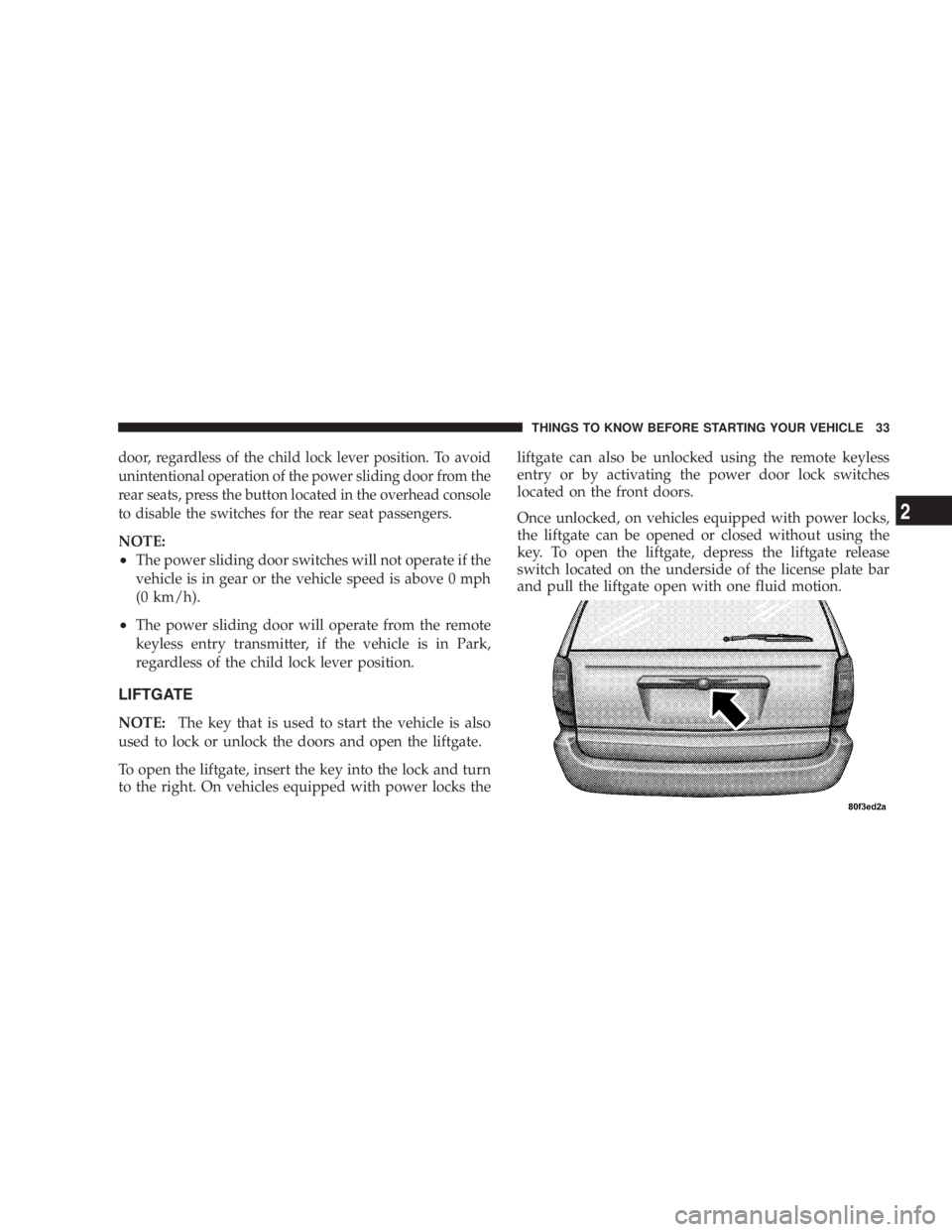
door, regardless of the child lock lever position. To avoid
unintentional operation of the power sliding door from the
rear seats, press the button located in the overhead console
to disable the switches for the rear seat passengers.
NOTE:
² The power sliding door switches will not operate if the
vehicle is in gear or the vehicle speed is above 0 mph
(0 km/h).
² The power sliding door will operate from the remote
keyless entry transmitter, if the vehicle is in Park,
regardless of the child lock lever position.
LIFTGATE
NOTE: The key that is used to start the vehicle is also
used to lock or unlock the doors and open the liftgate.
To open the liftgate, insert the key into the lock and turn
to the right. On vehicles equipped with power locks the liftgate can also be unlocked using the remote keyless
entry or by activating the power door lock switches
located on the front doors.
Once unlocked, on vehicles equipped with power locks,
the liftgate can be opened or closed without using the
key. To open the liftgate, depress the liftgate release
switch located on the underside of the license plate bar
and pull the liftgate open with one fluid motion. THINGS TO KNOW BEFORE STARTING YOUR VEHICLE 33
2
Page 38 of 397
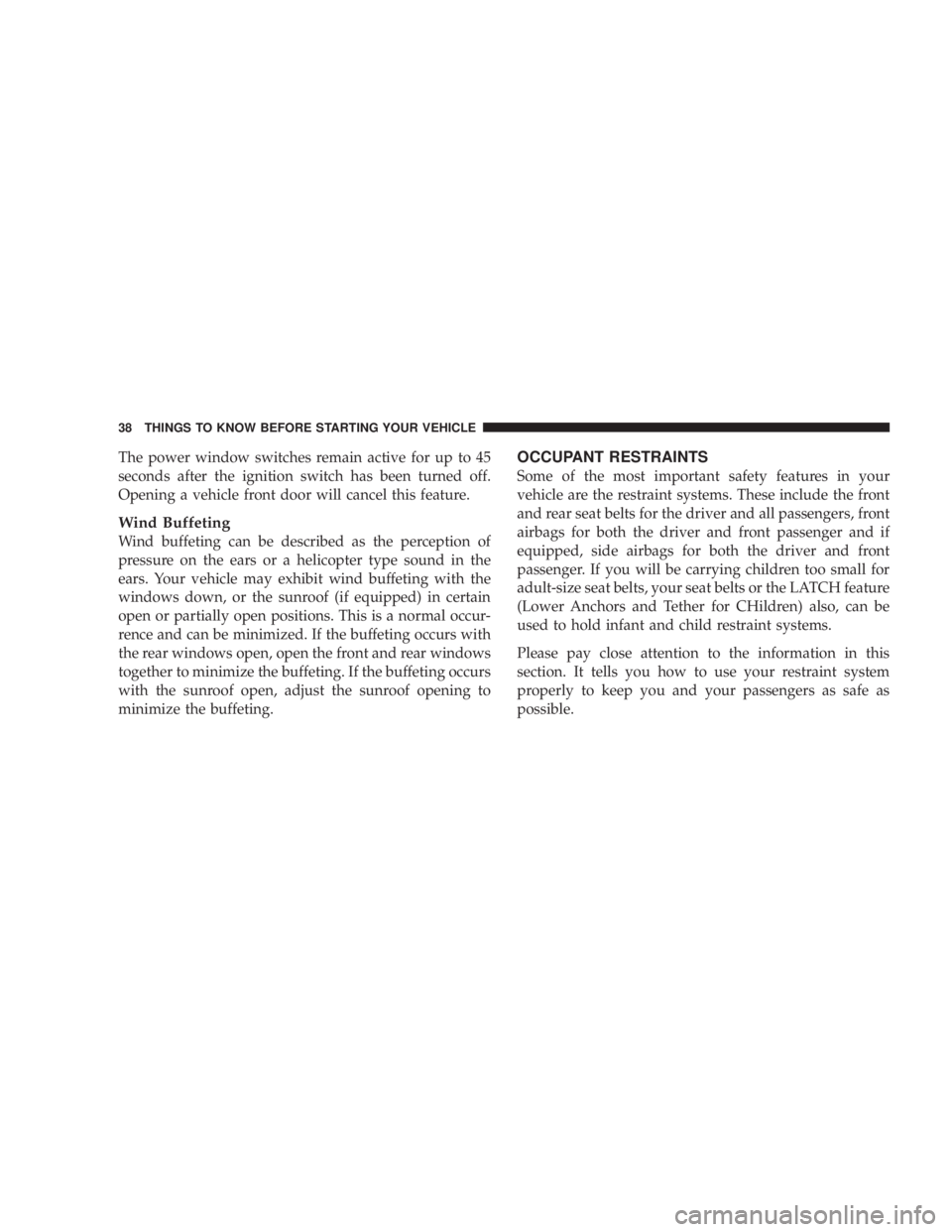
The power window switches remain active for up to 45
seconds after the ignition switch has been turned off.
Opening a vehicle front door will cancel this feature.
Wind Buffeting
Wind buffeting can be described as the perception of
pressure on the ears or a helicopter type sound in the
ears. Your vehicle may exhibit wind buffeting with the
windows down, or the sunroof (if equipped) in certain
open or partially open positions. This is a normal occur-
rence and can be minimized. If the buffeting occurs with
the rear windows open, open the front and rear windows
together to minimize the buffeting. If the buffeting occurs
with the sunroof open, adjust the sunroof opening to
minimize the buffeting. OCCUPANT RESTRAINTS
Some of the most important safety features in your
vehicle are the restraint systems. These include the front
and rear seat belts for the driver and all passengers, front
airbags for both the driver and front passenger and if
equipped, side airbags for both the driver and front
passenger. If you will be carrying children too small for
adult-size seat belts, your seat belts or the LATCH feature
(Lower Anchors and Tether for CHildren) also, can be
used to hold infant and child restraint systems.
Please pay close attention to the information in this
section. It tells you how to use your restraint system
properly to keep you and your passengers as safe as
possible.38 THINGS TO KNOW BEFORE STARTING YOUR VEHICLE
Page 51 of 397
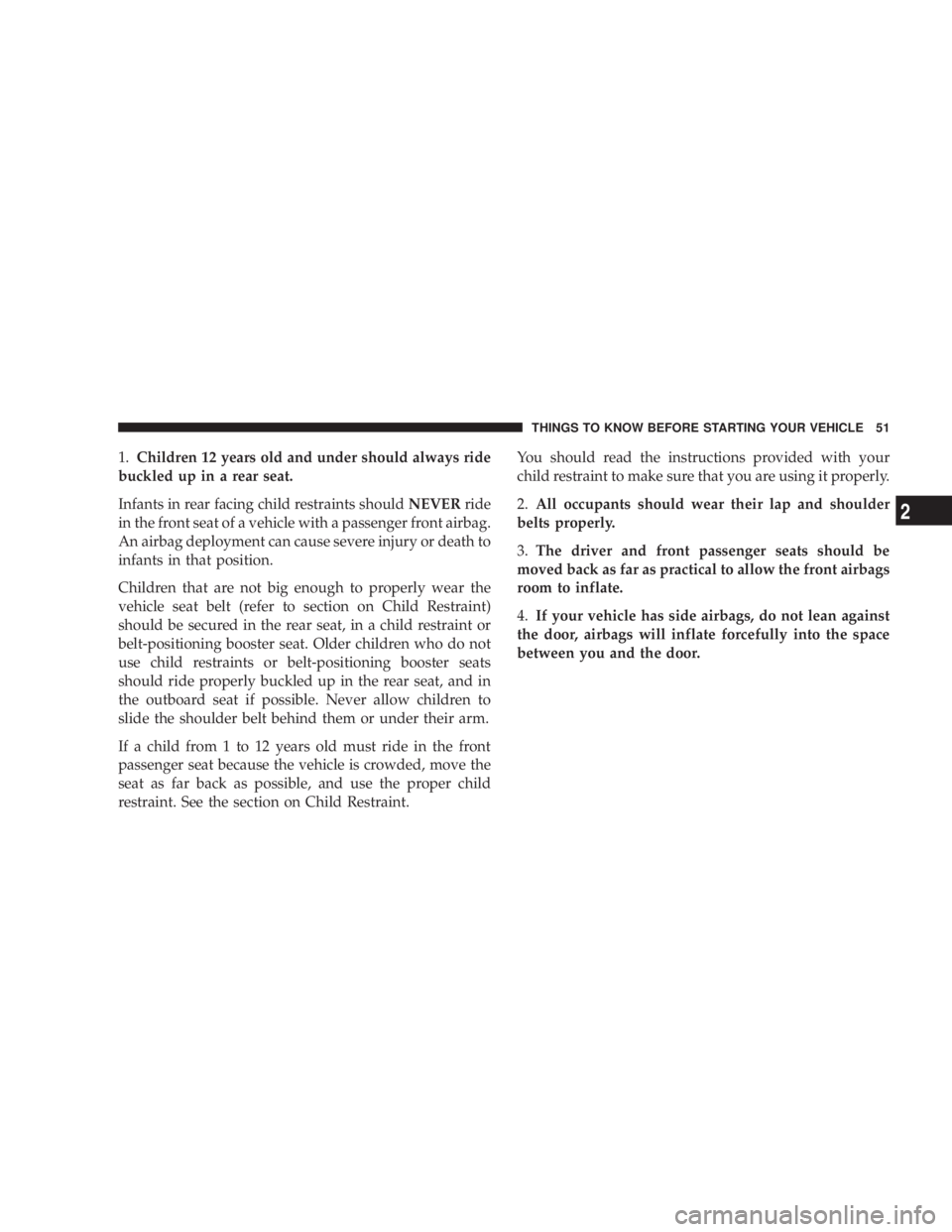
1. Children 12 years old and under should always ride
buckled up in a rear seat.
Infants in rear facing child restraints should NEVER ride
in the front seat of a vehicle with a passenger front airbag.
An airbag deployment can cause severe injury or death to
infants in that position.
Children that are not big enough to properly wear the
vehicle seat belt (refer to section on Child Restraint)
should be secured in the rear seat, in a child restraint or
belt-positioning booster seat. Older children who do not
use child restraints or belt-positioning booster seats
should ride properly buckled up in the rear seat, and in
the outboard seat if possible. Never allow children to
slide the shoulder belt behind them or under their arm.
If a child from 1 to 12 years old must ride in the front
passenger seat because the vehicle is crowded, move the
seat as far back as possible, and use the proper child
restraint. See the section on Child Restraint. You should read the instructions provided with your
child restraint to make sure that you are using it properly.
2. All occupants should wear their lap and shoulder
belts properly.
3. The driver and front passenger seats should be
moved back as far as practical to allow the front airbags
room to inflate.
4. If your vehicle has side airbags, do not lean against
the door, airbags will inflate forcefully into the space
between you and the door. THINGS TO KNOW BEFORE STARTING YOUR VEHICLE 51
2
Page 55 of 397
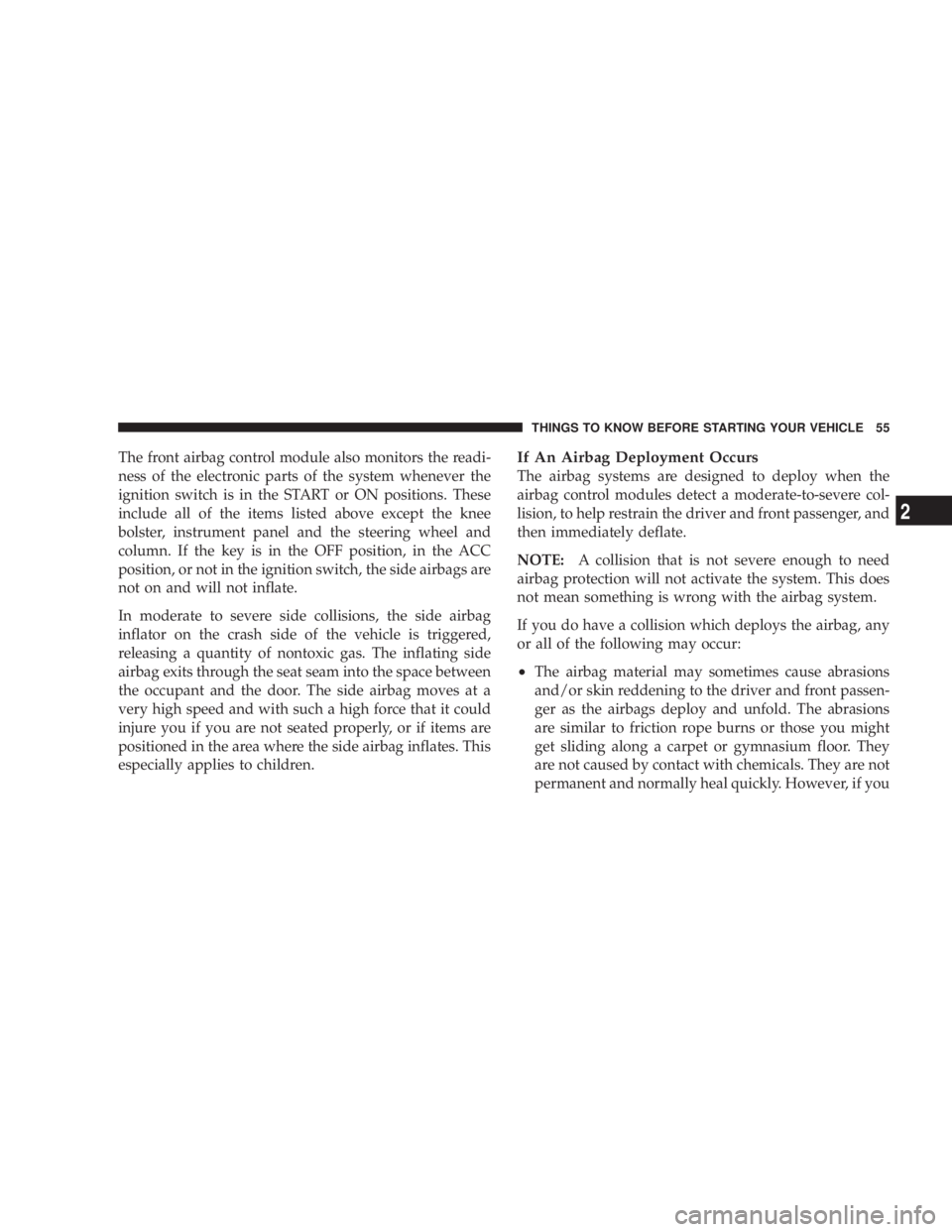
The front airbag control module also monitors the readi-
ness of the electronic parts of the system whenever the
ignition switch is in the START or ON positions. These
include all of the items listed above except the knee
bolster, instrument panel and the steering wheel and
column. If the key is in the OFF position, in the ACC
position, or not in the ignition switch, the side airbags are
not on and will not inflate.
In moderate to severe side collisions, the side airbag
inflator on the crash side of the vehicle is triggered,
releasing a quantity of nontoxic gas. The inflating side
airbag exits through the seat seam into the space between
the occupant and the door. The side airbag moves at a
very high speed and with such a high force that it could
injure you if you are not seated properly, or if items are
positioned in the area where the side airbag inflates. This
especially applies to children. If An Airbag Deployment Occurs
The airbag systems are designed to deploy when the
airbag control modules detect a moderate-to-severe col-
lision, to help restrain the driver and front passenger, and
then immediately deflate.
NOTE: A collision that is not severe enough to need
airbag protection will not activate the system. This does
not mean something is wrong with the airbag system.
If you do have a collision which deploys the airbag, any
or all of the following may occur:
² The airbag material may sometimes cause abrasions
and/or skin reddening to the driver and front passen-
ger as the airbags deploy and unfold. The abrasions
are similar to friction rope burns or those you might
get sliding along a carpet or gymnasium floor. They
are not caused by contact with chemicals. They are not
permanent and normally heal quickly. However, if you THINGS TO KNOW BEFORE STARTING YOUR VEHICLE 55
2
Page 58 of 397
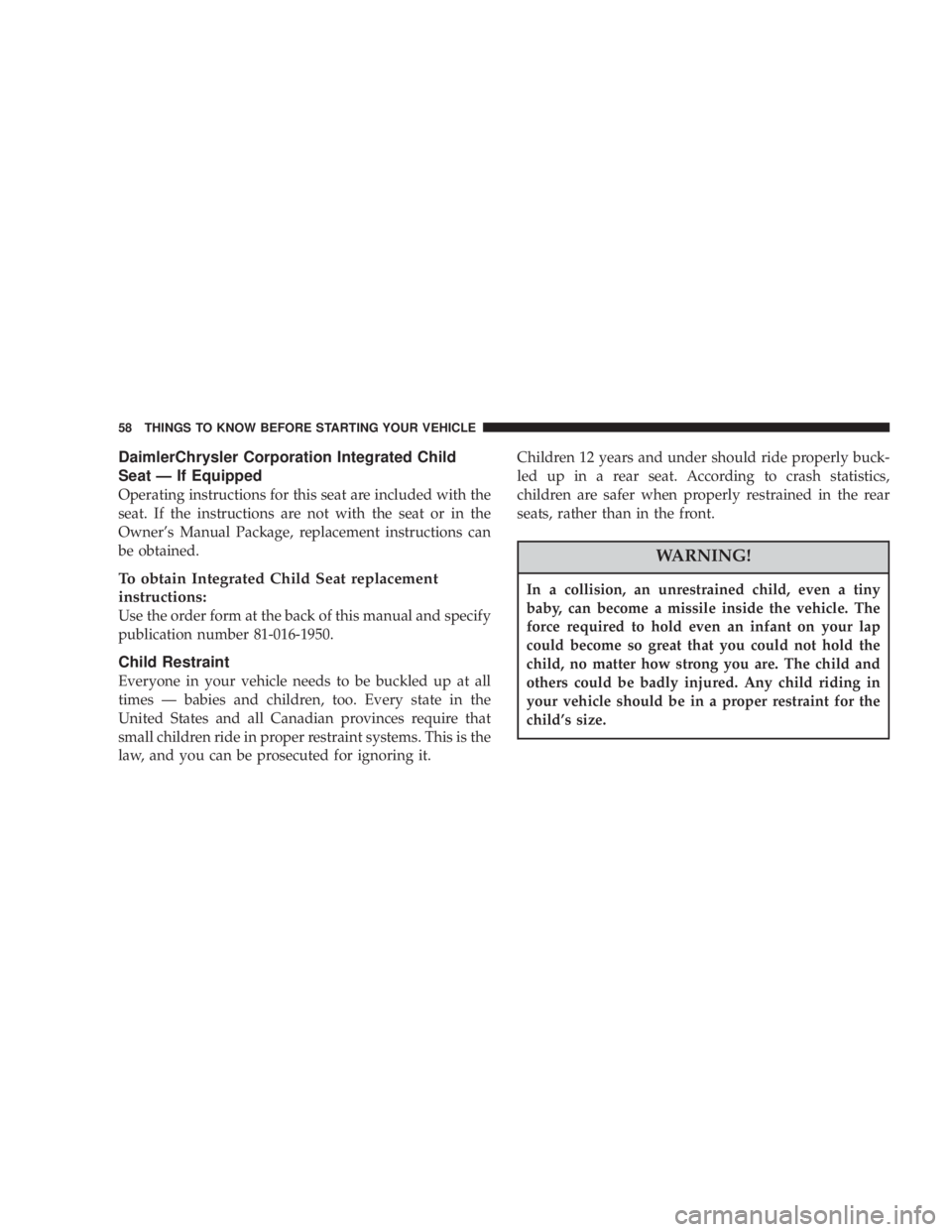
DaimlerChrysler Corporation Integrated Child
Seat Ð If Equipped
Operating instructions for this seat are included with the
seat. If the instructions are not with the seat or in the
Owner's Manual Package, replacement instructions can
be obtained.
To obtain Integrated Child Seat replacement
instructions:
Use the order form at the back of this manual and specify
publication number 81-016-1950.
Child Restraint
Everyone in your vehicle needs to be buckled up at all
times Ð babies and children, too. Every state in the
United States and all Canadian provinces require that
small children ride in proper restraint systems. This is the
law, and you can be prosecuted for ignoring it. Children 12 years and under should ride properly buck-
led up in a rear seat. According to crash statistics,
children are safer when properly restrained in the rear
seats, rather than in the front.
WARNING!In a collision, an unrestrained child, even a tiny
baby, can become a missile inside the vehicle. The
force required to hold even an infant on your lap
could become so great that you could not hold the
child, no matter how strong you are. The child and
others could be badly injured. Any child riding in
your vehicle should be in a proper restraint for the
child's size.58 THINGS TO KNOW BEFORE STARTING YOUR VEHICLE